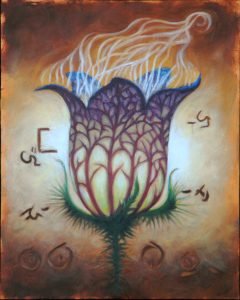
Virginia artist Jennifer Cox calls her latest series of paintings, Wanton Biophilia, describing them as “a mash-up of psychology and biology; the result of a lifetime of fascination with the natural world filtered through my subconscious, my experiences, my thought processes and philosophical leanings.”
Combining natural and imagined flora and fauna, Cox says, “I always start with what comes out of my head — whether I’m waking from a nap or envisioning something I’ve seen. I’m a voracious looker. I stop in the woods and look at mushrooms. sticks, branches against the sky. I’m always cramming in the visuals.
“I’m also reading biology and science. An idea keeps bugging me until I do something about it. It’s a way for me to deal with my obsessions of certain concepts and images. All my paintings mess the lines between biology and botany, botany and psychology.”
Cox adds that the script on her paintings, although resembling handwriting, is “wholly made up. Latin and greek come in when I title the paintings. I studied latin as a teenager, and have always loved taxonomy nomenclature, finding that the latin name for a plant stuck with me as a musical phrase might.”
The Alchemist’s Notebook, (pictured above) was inspired by botanists’ illustrations and symbols found in medieval chemical science and philosophy — alchemy a mixture of theology, chemistry and magic that created their own language and processes for curing diseases and extending life. In Cox’s evocative painting, the tulip-like flower spews its own mysteries –– whether smoke, steam or pollen.
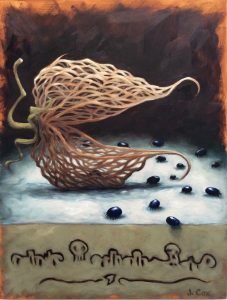
“Senium crepitans addresses the issue of decay, natural upset and change,” says Cox. “It pictures a dried pod, its seeds having sprouted into living bugs.”
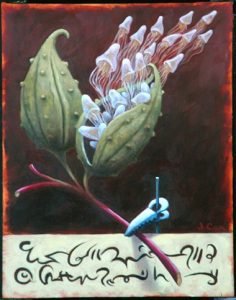
In Ascleplas cnidaria, Cox’s milkweed pods blossom with emerging jellyfish. She laughs.”It probably has something to do with sex but who knows.”
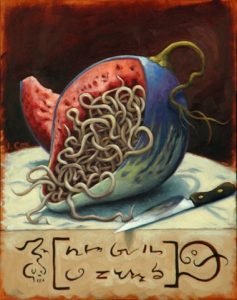
Cox began her fertile series over a decade ago, Strange Fruit 2, one of the first that set her on a new path, and created for the biennial ArtSpace ThinkSmall exhibition in Richmond, and was the first painting where the spiny fruit showed up. “It has reappeared in similar form many times since,” says Cox. “I think it’s a self portrait. The spiny fruit, that is.”
In developing her work over time, she took instruction and inspiration from contemporary artists Alexis Rickman — known for paintings that depict the consequences of climate change on the natural world, and Walton Ford another painter who imagines the human effects to our natural environment.

Raised in an evangelical Christian culture, Cox came to her present view of common creation after traveling to Mexico and discovering the creation myth in which we are all made from the same mother earth. “This became a rich and complex metaphor for me as a mother, artist and environmentalist who appreciates life and how we’ve too often disregarded our common creation.
“I feel the entire biome of the earth is made of the same building blocks – DNA – and that there isn’t as much difference between a human and a banana as one might think, when you look at our genomes. It’s just a difference in how the Legos are stacked up. We’re made of the same stuff. And in my probably fanciful imagination, a tweak here or there as we are starting to do with genetic engineering, might make an octopus grow inside a fruit on a vine. Or jellyfish erupt from a milkweed pod.”
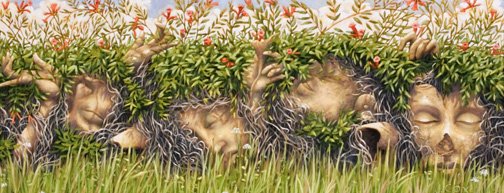
Campis Radicans from Cox’s earlier “goddess series” explores the theme of our common bond with mother earth, bodies broken, reassembled and given new life,” says Cox. She titled these paintings by the taxonomic name of the dominant plant in the painting, in this case, the trumpet vine.
Besides her current Wanton Biophilia series, Cox’s favorite subjects include Virginia streams, forests and mountains. She lives on a small farm in Rockbridge County, Virginia, and received her BFA in painting and printmaking in 1983 from Virginia Commonwealth University in Richmond. She earned a teaching fellowship from Bennington College, where in 1985, she received an MFA in painting.
Cox has shown widely in Virginia — from the William King Regional Arts center in Abingdon to Artspace Gallery, Richmond and Fayerweather Hall Gallery, University of Virginia. In 2006, Cox won Best in Show at the Nelson Fine Art Gallery in Lexington. Her work has been further exhibited at the Robeson Gallery, State College, Pa. and at the Korean and American International Exchange Exhibition – Daegu Art and Cultural Center, Daegu, South Korea.
Click here to see more of Cox’s work.
– Elizabeth Meade Howard, art editor
Follow us!Share this post with your friends.

We are ALL the same thing. That is a universal truth. “Strange fruit” is the name of a song by Billie Holiday and the strange fruit is the black man hanging from the tree, lynched by whites.